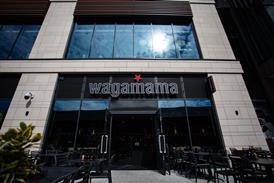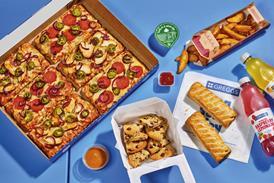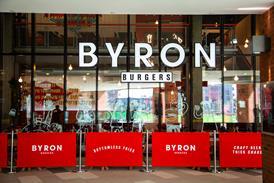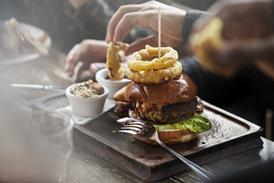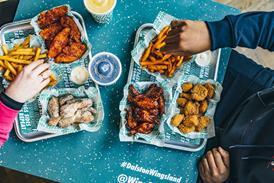Rising cattle prices, an uptick in non-beef products and a wish for customisation are all factors in the evolution of the burger sector. Darren Tristano takes an in-depth look at the patty
Ask the average restaurant goer to describe a quintessential American food favourite, and many will respond with “burgers”. The hamburger-and-fries tandem has been a beloved American menu staple for generations, and US foodservice consumers widely expect burgers to be available in a variety of different categories and formats when they dine out.
Despite the long-standing love for burgers, operators within the burger category are being tested by a number of challenges. Rising commodity costs – particularly for beef – have caused a major disruption since 2013. What’s happening to contribute to soaring beef prices? According to the US Bureau of Labor statistics, current cattle herds are the smallest they’ve been in more than six decades, pushing the price of beef to an all-time high.
The steady uptick in beef prices has not gone unnoticed by restaurant goers, and they have reacted by slightly reducing their consumption of burgers during the past two years.
This means that big burger chains like McDonalds and Wendy’s have had to work harder than ever to offset this downshift in purchase frequency.
Initially, major players in the burger category bulked up their menus, attempting to present consumers with a plethora of new choices to capture their attention and drive visits. However, this approach largely backfired; many customers were left feeling overwhelmed and confused about these expanded menus. This opened the door for ‘better burger’ concepts like Smashburger and Shake Shack to emerge, as more burger consumers went in search of higher quality ingredients, smaller menus and specialisation.
For Technomic’s newly released 2015 Burger Consumer Trend Report for the US market, we delved into this larger trend around burger specialisation and how this focus has translated into menu development. Our findings reveal movement toward burgers beyond beef; uniqueness in terms of toppings and globally inspired flavours; and, perhaps most importantly, the introduction of service formats that promote customisation.
Non-beef burgers
One of our most significant findings pointed to the proliferation of burger patties that feature proteins and other components beyond beef. ‘Veggie’ burgers are trending at both limited-service and full-service restaurants. Meanwhile, LSR (limited service restaurant) chains both inside and outside the burger category are also adding more chicken burgers, and FSR (full service restaurant) chains are adding more turkey burgers. At the same time, there are fewer hamburgers, cheeseburgers and bacon cheeseburgers being added to menus at leading brands in Technomic’s Top 500 restaurant chain segment.
Because poultry and vegetables generally carry a stronger perception of health than beef, non-beef burgers are gaining ground among a consumer base that is shying away from beef due to health concerns.
Additionally, the trend is also being driven by ‘flexitarian’ diners who eschew meat from time to time, as well as by vegan and vegetarian diners who, of course, always seek out non-meat options. The more visible availability of veggie burgers also helps diverse dining parties eliminate the veto vote, while chicken and turkey burgers provide less-expensive options that appeal to the price-conscious burger lover.
Casual-dining chain BJ’s Restaurant & Brewery recently added an Enlightened Turkey Burger containing 795 calories; White Castle introduced Veggie Sliders in late 2014; and fast-casual burger concept The Counter added two new turkey and chicken burger sliders.
Build-your-own formats
As build-your-own (BYO), fast-casual burger concepts prove to be a time-tested success with US diners, other restaurants are adopting this model in order to remain competitive among a customer base that continues to demand the ability to customise their food.
Quick serves in the burger category are now using BYO platforms to better position themselves and secure patronage from the 61% of younger consumers who say that it’s highly important that they can customise condiments and toppings for their burgers.
Staying on top of this trend, McDonalds is looking to reinvigorate its menu and service focus by testing ‘Create Your Taste’, a customisation platform that also extends to TasteCrafted, a kiosk format for BYO burgers. Wendy’s recently tested a BYO burger and chicken programme, and casual-dining chain Hurricane Grill & Wings, which offers a range of burgers, has also launched a new BYO burger option.
Many consumers will have a firm idea about the toppings and condiments they want for their burgers when they approach the counter; others will be more leisurely during their customisation decision.
A longer wait may be the convenience-related price that consumers will have to pay in order to build their own burger. But the good news is that almost half of consumers surveyed (44%) say that they’re willing to wait longer for a burger made to their specifications.
Flavourful speciality preparations
While the overall number of burger offerings has dipped, burger chains and other restaurant operators are still finding innovation avenues for speciality burgers. It’s part of the specialisation mindset that’s prevalent in the category today, and it’s giving chains more room to manoeuvre in the promotion of creative burgers for a limited time – rather than bloating the permanent menu.
We’re seeing US burger chains focusing more directly on big, bold flavours for burgers, especially in the vein of hot and spicy taste profiles. LSR and FSR alike are turning up the heat levels on burgers, by inflecting them with a variety of speciality ingredients.
On-trend flavour components include jalapeño peppers, which have increased in number on LSR burgers by 33% since 2013. We’re seeing pepper toppings ex-pand for burgers to include seasonal Hatch green chillies (also known as New Mexican chillies), ghost peppers, and habanero, chipotle and cayenne peppers and sauces. Speaking of sauces, other ultra-hot burger condiments to watch include Buffalo and Sriracha sauces. Other toppings and ingredients call for hot cheeses and burger buns, from pepper jack cheeses to jalapeño buns.
While it’s not prudent for operators and menu developers to jump on every flavour fad, it remains vital for the category to recognise and address the ever-growing consumer preference for spicy fare.
Technomic research finds that for burgers, one third (32%) of consumers say that they’d be likely to order a Tex Mex-style/south-western burger; 37% would order pepper jack cheese on their burger; and about a quarter (23%) of consumers would top their burger with jalapeño peppers.
Aside from the emerging flavour preferences, there’s also the novelty aspect to consider; this is where menus have the opportunity to spark interest among burger consumers for limited-time promotions. Fiery, spicy burgers that have multiple levels of heat can carry enough shock value to draw adventurous diners.
Smashburger recently launched a new Spicy Buffalo & Blue Cheese Burger; burger giant Wendy’s topped a new limited-time offer chicken burger with ghost pepper sauce, jalapeños, pepper jack cheese and a toasted red jalapeño bun for its Jalapeño Fresco Spicy Chicken Sandwich. And full-service Johnny Rockets has reintroduced its Spicy Houston Burger for a limited time. The speciality burger features jalapeños, pepper jack cheese and chipotle-ranch sauce.
Beyond the hot/spicy, Mexican-influenced trend, the outlook also calls for expansion of Asian-inspired speciality burgers. This global inspiration is currently taking root at emerging chains and independent restaurants.
Beijing burger concept Uncle Sam’s opened its first unit in the US in May. Its signature K-Town Burger features galbi beef, kimchi and fermented black bean. And in Chicago, independent restaurant bopNgrill showcases Korean-burger fusion, such as its Kimchi Burger, featuring caramelised kimchi, shredded cabbage and kimchi mayonnaise.
What’s the operator perspective?
Burger chains and restaurant operators that feature robust burger programmes are aware of the obstacles that continue to challenge their business.
When we asked more than 500 operators to illuminate the initiatives that they believe will make the most impact on burger concept and menu development, they pointed to the importance of strengthening their narratives around three major themes: quality, health and variety/customisation.
The operator response, coupled with our trend research, underscores the importance of premium meats, breads and garnishes to help heighten their quality story.
One way that operators are hoping to build this food story is by being more transparent about contemporary health attributes for burgers. Going forward, we expect to see more burger chains strongly tout the ‘free’ elements of their beef and other meats – such as hormone, antibiotic or steroid-free beef, as well as free-range and grass fed qualities.
And while rising costs and diminishing menu ranges is causing burger chains to focus on streamlining offerings, they understand that variety must always be emphasised.
Giving the customer a greater degree of control over interesting assortments of toppings and ingredients, while presenting them with patties beyond beef, will be the primary approach to menu development for leaders to fuel growth in the burger category.
Darren Tristano is senior managing director of Technomic Inc, a Chicago-based foodservice consultancy and research firm. Since 1993, he has led the development of Technomic’s information services division and directed multiple aspects of the firm’s operations. For more information, visit www.technomic.com.
Ask the average restaurant goer to describe a quintessential American food favourite, and many will respond with “burgers”. The hamburger-and-fries tandem has been a beloved American menu staple for generations, and US foodservice consumers widely expect burgers to be available in a variety of different categories and formats when they dine out.
Despite the long-standing love for burgers, operators within the burger category are being tested by a number of challenges. Rising commodity costs – particularly for beef – have caused a major disruption since 2013. What’s happening to contribute to soaring beef prices? According to the US Bureau of Labor statistics, current cattle herds are the smallest they’ve been in more than six decades, pushing the price of beef to an all-time high.
The steady uptick in beef prices has not gone unnoticed by restaurant goers, and they have reacted by slightly reducing their consumption of burgers during the past two years.
This means that big burger chains like McDonalds and Wendy’s have had to work harder than ever to offset this downshift in purchase frequency.
Initially, major players in the burger category bulked up their menus, attempting to present consumers with a plethora of new choices to capture their attention and drive visits. However, this approach largely backfired; many customers were left
feeling overwhelmed and confused about these expanded menus. This opened the door for ‘better burger’ concepts like Smashburger and Shake Shack to emerge, as more burger consumers went in search of higher quality ingredients, smaller menus and specialisation.
For Technomic’s newly released 2015 Burger Consumer Trend Report for the US market, we delved into this larger trend around burger specialisation and how this focus has translated into menu development. Our findings reveal movement toward burgers beyond beef; uniqueness in terms of toppings and globally inspired flavours; and, perhaps most importantly, the introduction of service formats that promote customisation.
Non-beef burgers
One of our most significant findings pointed to the proliferation of burger patties that feature proteins and other components beyond beef. ‘Veggie’ burgers are trending at both limited-service and full-service restaurants. Meanwhile, LSR (limited service restaurant) chains both inside and outside the burger category are also adding more chicken burgers, and FSR (full service restaurant) chains are adding more turkey burgers. At the same time, there are fewer hamburgers, cheeseburgers and bacon cheeseburgers being added to menus at leading brands in Technomic’s Top 500 restaurant chain segment.
Because poultry and vegetables generally carry a stronger perception of health than beef, non-beef burgers are gaining ground among a consumer base that is shying away from beef due to health concerns.
Additionally, the trend is also being driven by ‘flexitarian’ diners who eschew meat from time to time, as well as by
vegan and vegetarian diners who, of
course, always seek out non-meat options. The more visible availability of veggie
burgers also helps diverse dining parties eliminate the veto vote, while chicken and turkey burgers provide less-expensive options that appeal to the price-conscious burger lover.
Casual-dining chain BJ’s Restaurant & Brewery recently added an Enlightened Turkey Burger containing 795 calories; White Castle introduced Veggie Sliders in late 2014; and fast-casual burger concept The Counter added two new turkey and chicken burger sliders.
Build-your-own formats
As build-your-own (BYO), fast-casual burger concepts prove to be a time-tested success with US diners, other restaurants are adopting this model in order to remain competitive among a customer base that continues to demand the ability to customise their food.
Quick serves in the burger category
are now using BYO platforms to better position themselves and secure patronage from the 61% of younger consumers who say that it’s highly important that they can customise condiments and toppings for their burgers.
Staying on top of this trend, McDonalds is looking to reinvigorate its menu and service focus by testing ‘Create Your Taste’, a customisation platform that also extends to TasteCrafted, a kiosk format for BYO burgers. Wendy’s recently tested a BYO burger and chicken programme, and casual-dining chain Hurricane Grill & Wings, which offers a range of burgers, has also launched a new BYO burger option.
Many consumers will have a firm idea about the toppings and condiments they want for their burgers when they approach the counter; others will be more leisurely during their customisation decision.
A longer wait may be the convenience-related price that consumers will have to pay in order to build their own burger. But the good news is that almost half of consumers surveyed (44%) say that they’re willing to wait longer for a burger made to their specifications.
Flavourful speciality preparations
While the overall number of burger offerings has dipped, burger chains and other restaurant operators are still finding innovation avenues for speciality burgers. It’s part of the specialisation mindset that’s prevalent in the category today, and it’s
giving chains more room to manoeuvre in the promotion of creative burgers for a limited time – rather than bloating the permanent menu.
We’re seeing US burger chains focusing more directly on big, bold flavours for burgers, especially in the vein of hot and spicy taste profiles. LSR and FSR alike
are turning up the heat levels on burgers, by inflecting them with a variety of
speciality ingredients.
On-trend flavour components include jalapeño peppers, which have increased
in number on LSR burgers by 33% since 2013. We’re seeing pepper toppings ex-pand for burgers to include seasonal Hatch green chillies (also known as New Mexican chillies), ghost peppers, and habanero, chipotle and cayenne peppers and sauces. Speaking of sauces, other ultra-hot burger condiments to watch include Buffalo and Sriracha sauces. Other toppings and ingredients call for hot cheeses and burger buns, from pepper jack cheeses to jalapeño buns.
While it’s not prudent for operators and menu developers to jump on every flavour fad, it remains vital for the category to recognise and address the ever-growing consumer preference for spicy fare.
Technomic research finds that for burgers, one third (32%) of consumers say that they’d be likely to order a Tex Mex-style/south-western burger; 37% would order pepper jack cheese on their burger; and about a quarter (23%) of consumers would top their burger with jalapeño peppers.
Aside from the emerging flavour preferences, there’s also the novelty aspect to consider; this is where menus have the opportunity to spark interest among burger consumers for limited-time promotions. Fiery, spicy burgers that have multiple levels of heat can carry enough shock value to draw adventurous diners.
Smashburger recently launched a new Spicy Buffalo & Blue Cheese Burger; burger giant Wendy’s topped a new limited-time offer chicken burger with ghost pepper sauce, jalapeños, pepper jack cheese and a toasted red jalapeño bun for its Jalapeño Fresco Spicy Chicken Sandwich. And full-service Johnny Rockets has reintroduced its Spicy Houston Burger for a limited time. The speciality burger features jalapeños, pepper jack cheese and chipotle-ranch sauce.
Beyond the hot/spicy, Mexican-influenced trend, the outlook also calls for expansion of Asian-inspired speciality burgers. This global inspiration is currently taking
root at emerging chains and
independent restaurants.
Beijing burger concept Uncle Sam’s opened its first unit in the US in May. Its signature K-Town Burger features galbi beef, kimchi and fermented black bean. And in Chicago, independent restaurant bopNgrill showcases Korean-burger fusion, such as its Kimchi Burger, featuring caramelised kimchi, shredded cabbage and kimchi mayonnaise.
What’s the operator perspective?
Burger chains and restaurant operators that feature robust burger programmes are aware of the obstacles that continue to challenge their business.
When we asked more than 500 operators to illuminate the initiatives that they believe will make the most impact on burger concept and menu development, they pointed to the importance of strengthening their narratives around three
major themes: quality, health and
variety/customisation.
The operator response, coupled with
our trend research, underscores the
importance of premium meats, breads
and garnishes to help heighten their
quality story.
One way that operators are hoping
to build this food story is by being more transparent about contemporary health attributes for burgers. Going forward,
we expect to see more
burger chains strongly tout the ‘free’ elements of their beef and other meats – such as hormone, antibiotic or steroid-free beef, as well as free-range and grass fed qualities.
And while rising costs and diminishing menu ranges is causing burger chains to focus on streamlining offerings, they understand that variety must always
be emphasised.
Giving the customer a greater degree of control over interesting assortments of
toppings and ingredients, while presenting them with patties beyond beef, will be
the primary approach to menu development for leaders to fuel growth in the burger category.
Darren Tristano is senior managing director of Technomic Inc, a Chicago-based
foodservice consultancy and research firm. Since 1993, he has led the development of Technomic’s information services division and directed multiple aspects of the firm’s operations. For more information, visit www.technomic.com.



